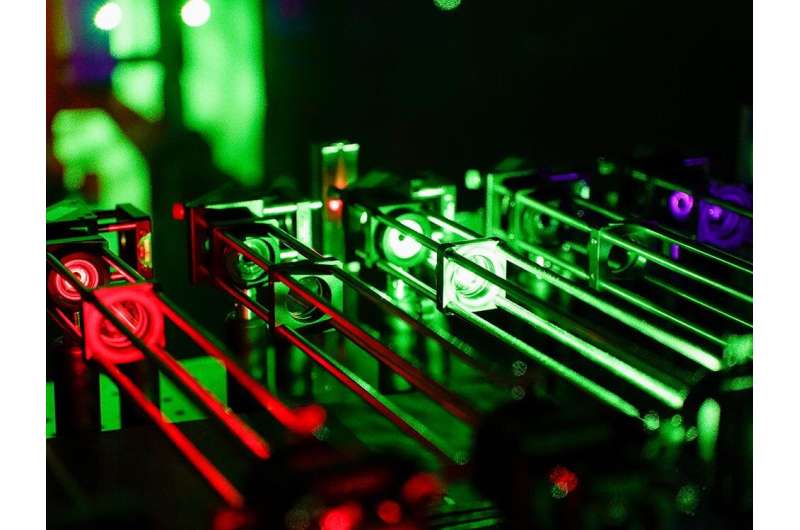This article has been reviewed according to Science X's editorial process and policies. Editors have highlighted the following attributes while ensuring the content's credibility:
fact-checked
peer-reviewed publication
trusted source
proofread
Neuron movements shown to be caused by push, pull of motor proteins

Neurons, which are responsible for producing the signals that ultimately trigger an action such as talking or moving a muscle, are built and maintained by classes of motor proteins that transport molecular cargo along elongated tracks called microtubules. A Penn State-led team of researchers uncovered how two main groups of motor proteins compete to transport cargo in opposite directions between the cell body and the synapse in neurons.
Through single-molecule fluorescence microscopy and computational modeling, the group investigated how three classes of one type of motor protein, known as kinesins, engage with another type of motor, dynein, during cargo transport. Their discoveries, published in eLife, can help scientists better understand the normal cargo transport process, and, in future work, inform how it is disrupted in the case of neurodegenerative diseases, such as Alzheimer's.
"Kinesin and dynein move along microtubules, which are over 1,000 times smaller than a piece of hair," said corresponding author William Hancock, Penn State professor of biomedical engineering (BME). "Because of the microtubules' structural polarity, kinesin motors bind to a cargo and pull it in one direction, carrying it toward the synapse, while dyneins bind and move in the opposite direction, back to the cell body of the neuron. When both motors bind to a cargo load at the same time, a competition between the two motors ensues, and how each performs determines how fast and in what direction the cargo will travel."
There are about a dozen different types of transport kinesins broken up into three families, while there is just one type of transport dynein. The researchers took a single kinesin motor from each of the three families and linked it to dynein. Using single-molecule fluorescence microscopy—where scientists observe individual, fluorescently labeled proteins and DNA molecules using high-powered cameras and lenses—they observed how the proteins moved along the microtubule.
"Each kinesin motor is like a different type of car on the road: One is a racecar, one is a SUV, one is a truck," Hancock said. "Some kinesin motors move short distances, some move long distances, some move faster and some move slower. Because the motors perform so differently from one another in isolation, we were surprised by what we found when we hooked them together with dynein."
Despite their apparent differences, researchers found that all three kinesin types performed equivalently against dynein: They all withstood dynein's hindering loads effectively.
To better understand the underlying mechanism, the researchers took their experimental results and developed a computational model, which indicated that the three kinesin types use different approaches for competing against dynein.
Kinesin-1 motors pull steadily against dynein, detaching relatively rarely from the microtubule track, but take some time to attach back. Kinesin-3 motors detach easily when pulling against dynein, but attach back to the microtubule track quickly, taking as little as a millisecond to start moving again. Kinesin-2 motors demonstrate a combination of the behaviors of kinesin-1 and -3.
The experimental results indicate that the mechanical properties of kinesin are not what determine the direction and speed of the cargo transport; something else is at play.
"The finding that kinesin-3 motors reattach to their track within a millisecond is striking, and we want to both confirm and understand the biophysical mechanisms underlying this fast reattachment," Hancock said. "We also plan to look at the regulation of the adapter molecules that connect the protein motors to their cargo, as well the mechanical stiffness of the cargo, to see if those factors play a role."
To do this, researchers will put the motors under different mechanical loads by connecting them to proteins with longer and longer pieces of DNA, while analyzing their movements under the microscope.
Understanding the intracellular transport system, as well as its vulnerability to mutations, can help scientists make advancements in the study of neurodegenerative conditions like Alzheimer's disease, Huntington's disease and Lou Gehrig's disease.
"It is clear that defects in intracellular transport are important aspects of neurodegenerative diseases, but the underlying mechanisms and how the transport defects contribute to the pathology are not clear," Hancock said. "With these new insights into the motor mechanisms of kinesin, we hope to interpret how mutations affect its transport ability and thereby compromise neuronal health."
More information: Allison M Gicking et al, Kinesin-1, -2, and -3 motors use family-specific mechanochemical strategies to effectively compete with dynein during bidirectional transport, eLife (2022). DOI: 10.7554/eLife.82228
Journal information: eLife
Provided by Pennsylvania State University




















